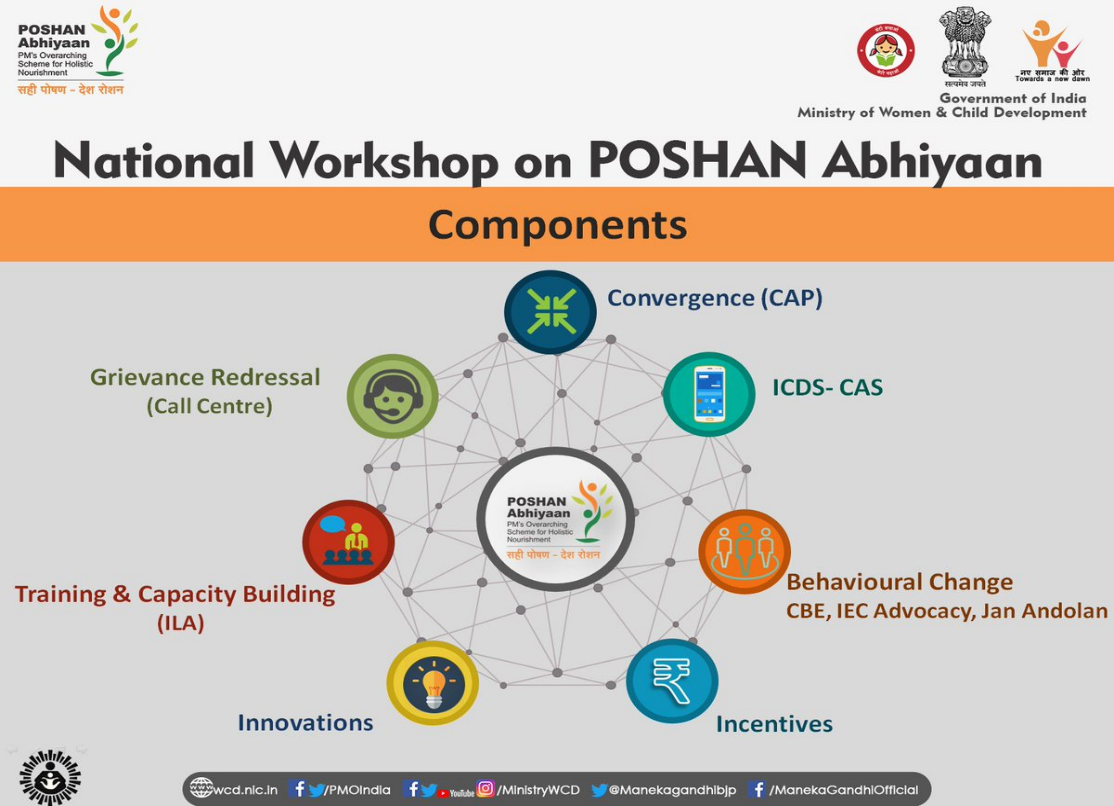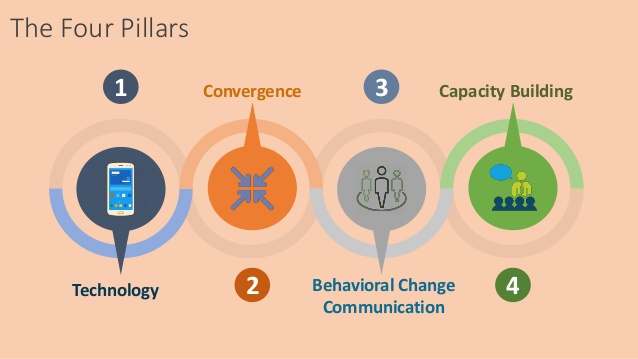MALNUTRITION & POSHAN ABHIYAAN
2020 MAR 17
Mains >
Social justice > Health > Nutrition

IN NEWS:
In the recently released ‘Transforming Nutrition in India: POSHAN Abhiyaan’, a progress report on POSHAN Abhiyan by NITI Aayog, Andhra Pradesh was ranked first among the larger states and Mizoram among the smaller states for overall implementation of POSHAN Abhiyaan.
MALNUTRITION:
According to WHO, malnutrition refers to deficiencies, excesses or imbalances in a person’s intake of energy and/or nutrients. The term malnutrition covers 2 broad groups of conditions.
- One is ‘undernutrition’—which includes stunting (low height for age), wasting (low weight for height), underweight (low weight for age) and micronutrient deficiencies or insufficiencies (a lack of important vitamins and minerals).
- The other is overweight, obesity and diet-related noncommunicable diseases (such as heart disease, stroke, diabetes and cancer)
INDIA'S NUTRITION SCENARIO:
- According to the UNICEF Report, Malnutrition caused 69% of deaths of children below the age of 5 in India.
- Every 2nd child in that age group is affected by some of malnutrition which include -
- Stunting (35%)
- Wasting (17%)
- Overweight (2%)
- Every 2nd woman is anaemic and its prevalence among adolescent girls is twice that of adolescent boys.
- Children under the age of 5 years are affected by micronutrient deficiencies – every 5th child under 5 is Vitamin A deficient, 1 in every 3rd baby has Vitamin B12 deficiency and 2 out of every 5 children are anaemic.
- Indian children are being diagnosed with adult diseases like hypertension, chronic kidney disease and pre-diabetic.
- Indian child diets are largely starved of proteins and micronutrients and are influenced by household (adult) food choices
POSHAN ABHIYAAN (National Nutrition Mission):
It is the Government of India's flagship program under the Ministry of Women and Child Development to improve nutritional outcomes for children, adolescents, pregnant women and lactating mothers by leveraging technology, a targeted approach and convergence.
- The idea is to holistically address the multiple determinants of malnutrition and attempts to prioritize the efforts of all stakeholders on a comprehensive package of intervention and services targeted on the first 1000 days of a child’s life.
- It seeks to do so through an appropriate governance structure by leveraging and intensifying the implementation of existing programs across multiple Ministries.
- And also, by roping in the expertise and energies of other stakeholders – State Governments, Communities, Think tanks, Philanthropic Foundations and other Civil Society Actors.
- It was proposed in the NITI Aayog's National Nutrition Strategy, 2017
- It aims to reduce:
- Child stunting by 2% per annum
- Underweight by 2% per annum
- Low birth weight by 2% per annum
- Anaemia among children (and young females) by 3 percentage per annum.
- It is based on 4 pillars:
- Ensuring access to quality services across the continuum of care to every woman and child; particularly during the first 1000 days of the child’s life.
- Ensuring the convergence of multiple programs and schemes: ICDS, PMMVY, NHM (with its sub components), Swachh Bharat Mission, National Drinking water Mission, NRLM etc.
- Leveraging technology, ICDS-CAS (ICDS Common Application Software) to empower the frontline worker with near real time information to ensure prompt and preventive action; rather than reactive one.
- Jan Andolan: Engaging the community to make it into a peoples’ movement inducing large scale behaviour change with the ownership of the efforts being vested in the community rather than government delivery mechanisms.

ISSUES:
A few issues that are emerging as the key binding constraints in the implementation of the Abhiyaan are -
- Gaps in Human Resources, particularly at the supervisory level especially lady supervisors
- Procurement and ICDS-CAS - only 27.6% of AWWs (Anganwadi workers) across the country have been provided with Smartphones and about 35% of AWWs have Growth Monitoring Devices (Infantometer, Stadiometer & Weighing Scales). Poor internet connectivity in remote rural areas and also lack of help-desk facilities for front line workers to help them navigate the software as first-time users
- Convergence - success in effective convergence of critical services at the household level has only been modest.
- Inadequate public health expenditure – At 1.28% of GDP (2017-18)
- Fund utilization - Variation in terms of utilization is observed across the country. The cumulative utilization rate is about 20% in the Large States; Small States and UTs have utilized on an average about 42% of the allocated funds.
- Lack of adequate infrastructure – According to World Health Statistics, India has very low hospital beds to population ratio of 0.9 beds per 1000 population
- Jan Andolan - to be sustained and strengthened further to induced behaviour change at a massive scale.
PRIORITISING HIGH IMPACT INTERVENTIONS:
A successful campaign must prioritize the high impact interventions taking into consideration the capacities of our delivery system. The following should be prioritised -
- Eliminate Diarrhoeal Deaths by focussing on prevention, rota virus vaccination, initiating timely treatment by giving ORS and Zinc and finally referral to a nearby health facility in case of complications.
- A huge campaign around improving complementary feeding practices
- Improve the quality of home visits through better implementation of the intensified and augmented Home-Based Newborn Care (HBNC) programme
- A very strong movement around ‘Anaemia Mukt Bharat’ Campaign
- Taking the agenda of food fortification ahead.
- Fixing the delivery and supply logistics of the Take Home Rations (THR) to pregnant and lactating mothers and children.
WAY FORWARD:
- Empower families, children and young people to demand nutritious food: Stimulating demand for nutritious foods means not only educating consumers on the benefits of healthy diets, but also leveraging cultural and social aspirations
- Drive food suppliers to do the right thing for children: Healthy food must also be available, affordable, safe, and convenient. Food producers and suppliers have a key role to play, and so do governments, which must create a level playing field for all producers and suppliers, ensuring their actions align with children’s best interests.
- Build healthy food environments: mandatory front-of-pack labelling and protection against exploitative marketing and mandatory labelling can help create food environments conducive to nutritious diets for children
- Mobilize supportive systems to scale up nutrition results: The health, water and sanitation, education and social protection systems must all deliver interventions in a coordinated fashion.
- Collect, analyze and use good-quality data and evidence regularly to guide action and track progress.
CONCLUSION:
- Children have unique nutritional needs and can suffer unique harm from malnutrition. Putting children’s needs first is key to ensuring that every child and young person has the nutrition they need to get the best start in life.
- Further, all children, adolescents, pregnant women and lactating mothers will need nutritious, affordable and sustainable diets if societies are to meet the economic, social and environmental challenges of our changing world in the 21st century. POSHAN Abhiyaan is an important step in this regard.
PRACTICE QUESTION:
Q. Despite the multiplicity of schemes catering to the health of children and women, level of malnutrition in India remains high. In this context, analyze the relevance of the strategies adopted by the POSHAN Abhiyaan in solving the issues of malnutrition in India?

